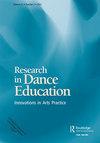Editorial
IF 0.8
3区 艺术学
0 DANCE
引用次数: 0
Abstract
Welcome to this issue of Research in Dance Education. The journal continues to thrive with global engagement from the readership and authors. I wish to thank all the reviewers that support the journal on a voluntary basis. I am pleased that the call for papers for the next special issue of Research in Dance Education: Leadership in Dance Education, guest editor Edward C Warburton, is out now. The articles in this issue represent work from the US, the UK, China, Japan and New Zealand. Themes of inclusivity, support, challenge and ownership, whilst developing an enabling, culturally responsive and democratic teaching environment for all to thrive in dance, are important takeaways from this issue. I am reminded of the value in choice of pedagogy in the teaching and learning relationship. I open this issue with Nyama McCarthy-Brown and Karen Shupp’s article “Gatekeepers to gateway-makers: reimaging partnerships, collaborations, and celebrations of the many movers of university campuses”. The authors reveal the inclusive range of extracurricular dance clubs that exist across college campuses and outside the embodied Whiteness of dance major courses in the US. Such extracurricular activities embrace a broad range of dance styles and cultural contexts that welcome all students to engage with dance. Using Critical Race Theory in relation to where, how, why and what dance occurs across campus, this article asks dance educators to carefully consider if we are gatekeepers or gateway-makers when it comes to providing students access to professional aspirations via a college degree. The research recognises the power and value of culturally responsive dance opportunities, as a way of building social connections and community, through performance and dance events. The authors suggest that there are ways of harnessing the interests of those engaging in dance across university campuses, by opening possibilities for shared studio spaces for example, to celebrate more people dancing. This article is relevant to dance educators working in university/dance contexts beyond the US. Next, Nico Kolokythas et al., in “Growth, maturation, and overuse injuries in dance and aesthetic sports: a systematic review”, undertook a database search using standard methods for article identification, selection and risk of bias appraisal. The eligibility criteria for inclusion in the study consisted of peer-reviewed articles using any type of study design. Twenty-three studies were selected that were cross-sectional in design and that focused on dance, gymnastics and diving. Of the 23 studies, 19 indicated a positive association between growth, maturation and overuse injuries, and a further 6 reported a positive association with training load. However, it is acknowledged that there were inconsistencies in associations of growth and maturation, and high or unclear risk of bias. It is suggested that there is a lack of reliable and valid research available on growth, maturation and training load in association with overuse injuries in dance and aesthetic sports. RESEARCH IN DANCE EDUCATION 2023, VOL. 24, NO. 2, 97–98 https://doi.org/10.1080/14647893.2023.2213089社论
欢迎收看本期《舞蹈教育研究》。该杂志在读者和作者的全球参与下继续蓬勃发展。我要感谢所有自愿支持该杂志的审稿人。我很高兴《舞蹈教育研究:舞蹈教育中的领导力》下一期特刊的论文征集,客座编辑Edward C Warburton已经发出。本期文章代表美国、英国、中国、日本和新西兰的作品。包容性、支持、挑战和所有权的主题,同时为所有人在舞蹈中茁壮成长创造一个有利的、文化上有反应的和民主的教学环境,是这个问题的重要收获。我想起了在教学关系中选择教育学的价值。我以Nyama McCarthy Brown和Karen Shupp的文章《网关制造商的守护者:重塑大学校园众多推动者的伙伴关系、合作和庆祝活动》来开启这一问题。作者揭示了美国大学校园和舞蹈专业课程白人化之外存在的各种课外舞蹈俱乐部。这些课外活动涵盖了广泛的舞蹈风格和文化背景,欢迎所有学生参与舞蹈。本文利用批判性种族理论,结合校园内舞蹈的地点、方式、原因和内容,要求舞蹈教育工作者在通过大学学位为学生提供职业抱负时,仔细考虑我们是守门人还是门户制造者。这项研究认识到了文化响应舞蹈机会的力量和价值,它是通过表演和舞蹈活动建立社会联系和社区的一种方式。作者建议,有一些方法可以利用大学校园里从事舞蹈的人的兴趣,例如,通过开放共享工作室空间的可能性,来庆祝更多的人跳舞。这篇文章与在美国以外的大学/舞蹈环境中工作的舞蹈教育工作者有关。接下来,Nico Kolokythas等人在“舞蹈和审美运动中的成长、成熟和过度使用伤害:系统综述”中,使用标准方法对文章进行了数据库搜索,以确定、选择和评估偏倚风险。纳入研究的资格标准包括使用任何类型研究设计的同行评审文章。选择了23项研究,这些研究在设计上是横断面的,重点是舞蹈、体操和跳水。在23项研究中,19项表明生长、成熟和过度使用损伤之间存在正相关,另有6项报告与训练负荷呈正相关。然而,人们承认,在生长和成熟的关联方面存在不一致,偏见的风险很高或不明确。这表明,在舞蹈和美学运动中,缺乏关于生长、成熟和训练负荷与过度使用损伤相关的可靠和有效的研究。舞蹈教育研究2023,第24卷,第2期,97–98https://doi.org/10.1080/14647893.2023.2213089
本文章由计算机程序翻译,如有差异,请以英文原文为准。
求助全文
约1分钟内获得全文
求助全文
来源期刊

Research in Dance Education
DANCE-
CiteScore
2.50
自引率
30.00%
发文量
35
期刊介绍:
Research in Dance Education aims to inform, stimulate lively and critical debate and promote the development of high quality research and practice in dance education. The journal is relevant to dance academics, teachers and learners. The journal includes contributors from a wide and diverse, international community of researchers. This extends to all aspects of dance in education, providing opportunities for both experienced and less experienced researchers. The journal encourages a wide range of research approaches and methods, in a forum for debate. Issues related to pedagogy, philosophy, sociology and methodology in relation to creating, performing and viewing dance in various contexts are welcome. The role and value of dance as part of arts education and the connections with other arts practitioners is also supported. The research field of Research in Dance Education includes for example: all phases of education, pre-school to higher education and beyond; teaching and learning in dance, theory and practice; embodiment; new technologies; systematic reviews of literature; professional dance artists in education; learning in and through dance; aesthetic and artistic education; dance and the arts; dance and physical education; training dance teachers: initial teacher education, continuing professional development, dance degrees, and professional dance training; examination dance; dance therapy; special educational needs; community dance and youth dance; dance in society: gender, ethnicity, class, religion, economics; psychological issues: self esteem, motivation, body image; creativity; philosophy and the arts; research methods and methodologies.
 求助内容:
求助内容: 应助结果提醒方式:
应助结果提醒方式:


